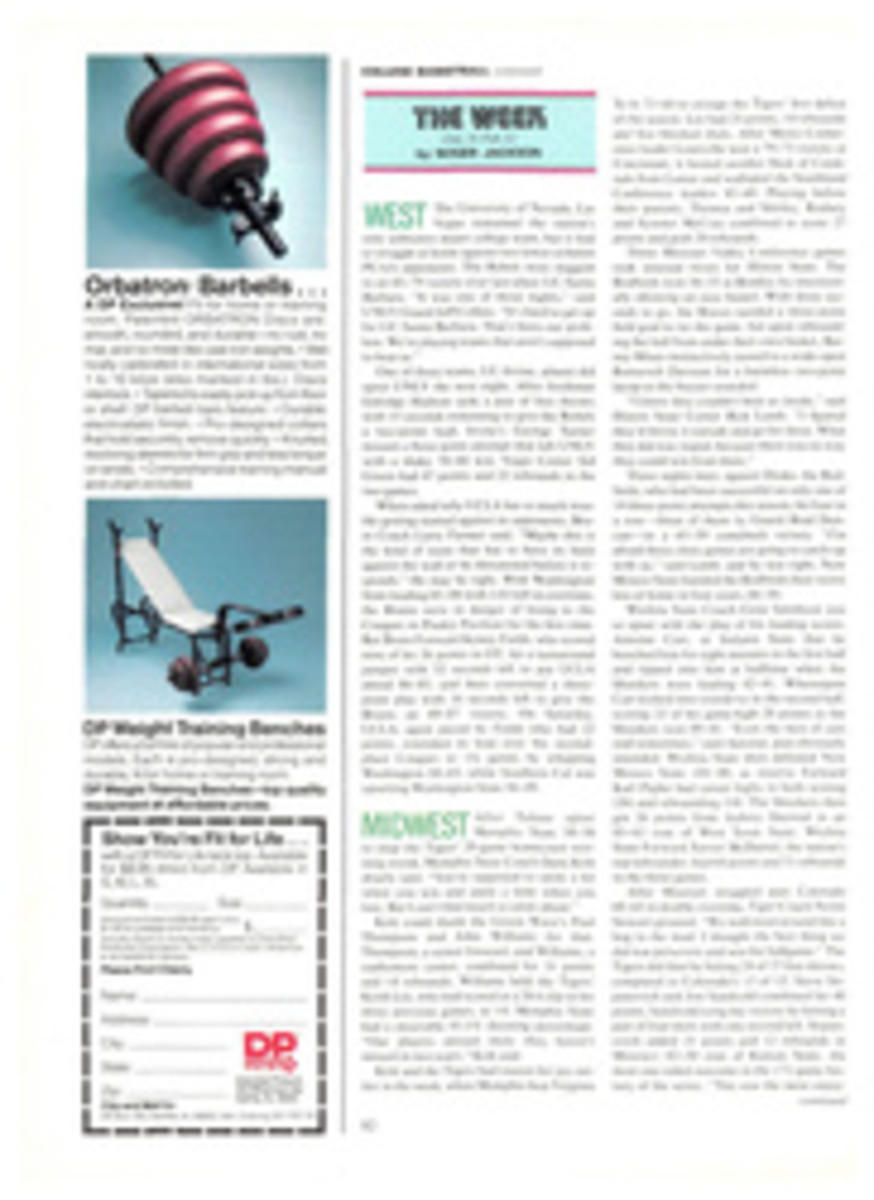
The thinner was the winner
The 1983 U.S. Figure Skating Championships may be remembered not as the meet in which Rosalynn Sumners emerged doll-like from the gloam to become the new princess of American skating; not for Elaine Zayak's game but futile attempt to recapture the title she'd won in 1981 and then frittered away in a series of crashes in 1982; and, perhaps, not even as the first step in reconciling art and athleticism in American women's figure skating. No, these championships may be remembered, as far as the women were concerned anyway, as figure skating's version of the Battle of the Bulge. Throughout the week, there was as much talk about calories, adipose tissue and fad diets as there was about Salchows, double Axels and sit spins. In the end the card-cutter's axiom in poker—thin to win—was embraced by the champion and runner-up alike, leaving observers with the feeling that the only real loser at the Civic Arena in Pittsburgh was the American Dairy Association.
Of course, the women weren't the whole show. Judy Blumberg and Michael Seibert dazzled the judges in the dance competition, earning five perfect 6.0 scores, the only ones awarded all week. In the pairs, Peter and Kitty Carruthers of Burlington, Mass. won their third straight national title, and senior men's champion Scott Hamilton of Denver skated nearly flawlessly to hold off 19-year-old Brian Boitano of Sunnyvale, Calif. Hamilton calls Boitano "probably the finest jumper I've ever seen," but Hamilton is still in a lofty class by himself. Next month in Helsinki he will defend his world championship for the third time, and he and the other U.S. skaters will get an idea of how they stand heading into the 1984 Olympics.
But Hamilton is looking forward to Helsinki for more reasons than the competition. It's there that he will unveil a new skating outfit that he promises will be "controversial." Concerned with the effeminate image that male figure skaters have been saddled with—one that's not entirely undeserved, it should be noted—Hamilton plans to wear a costume that's styled after those worn by speed skaters and gymnasts. "Some of the outfits you see out there now remind me of bad lounge acts," Hamilton said last week. He might have been describing the sequined, royal-blue costume that he wore during Saturday night's long-program competition. "I think I'm going to commit myself tonight by burning this," he said following the awards ceremony. "The professionals emphasize the artistic side of figure skating, and that's fine. But as long as we're an Olympic sport, I think the emphasis in the amateur ranks should be on the athletic side."
That debate—is it a sport or is it an art?—was central to the drama in the women's championship. "The sport's going through an athletic stage right now," Peggy Fleming, the 1968 Olympic gold medalist who is now a TV commentator, said on the eve of the competition. "I've always liked the artistic side, and I think the two sides will have to come closer together. Right now the balance of power is in the hands of the triple-jump people."
The head of the triple-jump movement within the women's ranks is Zayak, the defending world champion. She won the 1981 nationals as a precocious 15-year-old, fell three times in her free-skating program to lose the American title in 1982 and then performed seven triples en route to becoming world champion a month later. She came to Pittsburgh to regain the U.S. championship and pick up momentum for this year's worlds. To do so, Zayak had to dethrone 18-year-old Rosalynn Sumners of Edmonds, Wash., the fair-skinned, green-eyed beauty who'd seemingly won the 1982 national title by default. In Pittsburgh Sumners' coach, Lorraine Borman, was saying, "This year Rosalynn would like very much to prove that she can be both athletic and beautiful. We have four triples in our program, which I think is too many. But if that's what she wants, I'll go along with it. It's very important to her."
The last 12 months have not been easy for Sumners. After winning her crown last year, she became enamored of her instant celebrity and her discipline suffered. "You get to a certain status in skating by being left alone to train," says Hamilton. "And when Rosalynn got to the top she didn't know how to deal with the press, how to say no, how to cope with Zayak's finishing third in the nationals and then winning the worlds."
Over the summer Sumners gained weight, and when her skating suffered, she lost confidence. "The turning point came the last day of the NHK Trophy competition in Tokyo, shortly after Thanksgiving," she says. "I was pushing a salad around my plate, I had no confidence, didn't know what I wanted to do next, when my mom said, 'You want to know what I really think? You're lugging around too much weight.' That wasn't the first time someone had told me that, but before I would just say to myself, 'I'll show them,' and go get something to eat."
This time Sumners went on a diet that excluded sugar, bread, dairy products and most red meat and included 64 ounces of water every day. In the next eight weeks she dropped from 121 pounds to 104. She was now six pounds lighter than she had been when she won her U.S. title, and she'd never felt better. "Rosalynn just decided one day that she wanted to be great," says Hamilton, who was in Japan at the time Sumners made that commitment. "And once she did, I've never seen anybody work harder. She went to bed early to get up early. She had to prove to herself that winning the nationals last year wasn't a fluke."
Things went well from the start for Sumners in Pittsburgh. She stood second after Wednesday's compulsory figures, which accounts for 30% of the scoring. Zayak was fourth, which didn't overly concern her coaches. Mary Lynn Gelderman, who assists Peter Burrows in coaching Zayak, said, "Elaine likes to be a fighter, a scrapper. If she were sitting ahead, I'm not sure it would be good for her. She might skate a little flat." Zayak's terrier-like determination has led her to be called the Pete Rose of figure skating, but what had some of her followers concerned was that she arrived at the nationals carrying a stocky Rosean physique as well.
The rivalry between the two camps revealed itself intermittently. On Thursday morning after practice, Sumners' mother, Betty, chuckled as a reporter tried to get past her to talk to her daughter and said, "So now you all want to talk to Rosalynn. Both skaters have been out here the same amount of time, but for the last four years all anyone wrote about was Elaine."
"It's kind of a weird situation," said Zayak the morning of the short program, the two-minute freestyle event that counts for 20% of a skater's total score. "I'm sure if the press didn't play Roz and me off against each other so much, we might be friendlier."
That night both women skated clean programs, but Sumners scored all 5.8s and 5.9s on presentation points while Zayak received some 5.4s and 5.5s. "God, they love her," one skater said as Sumners' scores were flashed. "She shows a lot of style out there, a lot of pizzazz, which Elaine lacks."
Gelderman admitted that Zayak's performance "lacked some of the fire that she needs," but promised that it would be there tomorrow in the long program, which counted for 50% of the scoring.
Sumners, meanwhile, was radiant. As she was being ushered toward the post-performance press conference, Borman passed a December 1982 copy of Skating magazine that had a picture of Sumners in heavier days on its cover. "Look at this, Blob Baby!" Borman called to her, using a shocking nickname, given her present appearance.
At the conference Sumners treated the press to a much-needed lecture on nutrition, saying, "With fad diets you lose the fat between the muscle and the bone, which is called adipose. That's the fat you want. Don't laugh, I want to tell you this. What I lost is that other kind, the fat you don't want." Surreptitiously reporters began pinching themselves and making mental notes: no dairy products, no bread, no sugar.
Alas, the next night during Sumners' long program she fell trying a triple Salchow, and that slip probably cost her a perfect score. As it was, she received 5.9s across the board for composition and style. Sumners skated with elegance and verve, her skates seeming to dance above rather than on the ice.
Zayak finished second, skating a clean program that seemed workmanlike in comparison to Sumners'. In third was 15-year-old Tiffany Chin of Toluca Lake, Calif., who will join Sumners and Zayak in Helsinki.
In the locker room immediately afterward, some of Zayak's old fight resurfaced. "I know what I have to do to win and I'll be damned if I'm going to let this happen again," she said. What might that be? "I'm going to lose 10 pounds," she promised. "Before I went out there tonight I prayed that if I skated a clean program, I'd lose 10 pounds. So if I don't, I'll be in a bind with God. I felt heavy on the ice. I did the jumps all right, but they looked slow. They didn't have the spark they had a year or two ago."
Gelderman agreed. "This is not a new issue with us," she said. "We've been telling Elaine, 'You can't jump at that weight.' But she proved us wrong. She can. She can jump at any weight. But now she realizes it affects her speed, her overall appearance and her lightness on her feet. It's supposed to look like there's no gravity out there."
It did—for Sumners. Which helps explain the diet that Zayak has chosen: no dairy products, no bread, no sugar, little red meat. Thin to win.
As Borman says, "I don't think these two girls are through with each other yet."
PHOTO
Eschewing sugar, bread and red meat gave Sumners winning form.
PHOTO
After his win, Hamilton planned to burn his sequins.

